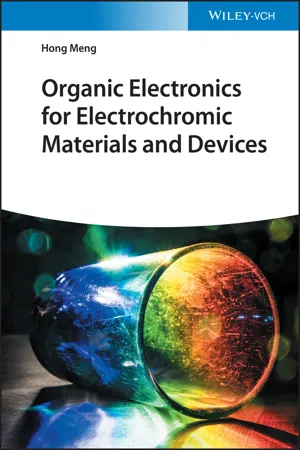
- English
- ePUB (mobile friendly)
- Available on iOS & Android
Organic Electronics for Electrochromic Materials and Devices
About this book
Explore this comprehensive overview of organic electrochromic materials and devices from a leading voice in the industry
Organic Electronics for Electrochromic Materials and Devices delivers a complete discussion of the major and key topics related to the phenomenon of electrochromism. The text covers the history of organic electrochromism, its fundamental principles, different types of electrochromic materials, the development of device structures and multi-function devices, characterizations of device performance, modern applications of electrochromic devices, and prospects for future electrochromic devices.
The distinguished author places a strong focus on recent research results from universities and private firms from around the world and addresses the issues and challenges faced by those who apply organic electrochromic technology in the real world. With these devices quickly becoming the go-to display technology in the field of electronic information, this resource will quickly become indispensable to all who work or study in the field of optics.
Readers will also benefit from the inclusion of:
- A thorough introduction to organic electrochromism, including its history and the mechanisms of electrochromic devices
- An exploration of polymer electrolytes for electrochromic applications, including their requirements and types
- A discussion of electrochromic small molecules, including the development of technology in viologen materials, fluoran and fluorescein dyes, violene-cyanine hybrids, triarylamine molecules and liquid crystal electrochromic materials.
- A perspective analysis of the redox-active conjugated polymers and triarylamine based non-conjugated polymers applied in electrochromic devices
- A treatment of Prussian blue and metallohexacyanates, including their backgrounds, technology development, crystal structures, synthesis, nanocomposites, and assembled electrochromic devices
Perfect for materials scientists, polymer chemists, organic chemists, physical chemists, and inorganic chemists, Organic Electronics for Electrochromic Materials and Devices will also earn a place in the libraries of physicists and those who work in the optical industry who seek a one-stop reference that covers all aspects of organic electrochromic materials.
Frequently asked questions
- Essential is ideal for learners and professionals who enjoy exploring a wide range of subjects. Access the Essential Library with 800,000+ trusted titles and best-sellers across business, personal growth, and the humanities. Includes unlimited reading time and Standard Read Aloud voice.
- Complete: Perfect for advanced learners and researchers needing full, unrestricted access. Unlock 1.4M+ books across hundreds of subjects, including academic and specialized titles. The Complete Plan also includes advanced features like Premium Read Aloud and Research Assistant.
Please note we cannot support devices running on iOS 13 and Android 7 or earlier. Learn more about using the app.
Information
1
Introduction
1.1 General Introduction


1.2 The History of Electrochromic Materials
Table of contents
- Cover
- Table of Contents
- Title Page
- Copyright
- Preface
- About the Author
- 1 Introduction
- 2 Advances in Polymer Electrolytes for Electrochromic Applications
- 3 Electrochromic Small Molecules
- 4 Viologen OEC
- 5 Metallohexacyanates
- 6 Electrochromic Conjugated Polymers (ECPs)
- 7 TA‐Based Electrochromic Polyimides and Polyamides
- 8 Metallo‐Supermolecular Polymers
- 9 Metal‐Organic Framework (MOF)‐ and Covalent Organic Framework (COF)‐Based Electrochromism (EC)
- 10 Nanostructure‐Based Electrochromism
- 11 Organic Electroluminochromic Materials
- 12 Organic Photoelectrochromic Devices
- 13 Application of OEC Devices
- 14 Commercialized OEC Materials and Related Analysis of Company Patents
- 15 Main Challenges for the Commercialization of OEC
- Index
- End User License Agreement